Your Cart is Empty
🙏HELP US SAVE TIGERS!🐅 WE DONATE 1% OF OUR SALES TO WILDLIFE ORGANIZATIONS ( WWF ...)
Menu

🙏HELP US SAVE TIGERS!🐅 WE DONATE 1% OF OUR SALES TO WILDLIFE ORGANIZATIONS ( WWF ...)
How Fast Can a Jaguar Run: Top Speeds and Facts
April 21, 2024 7 min read
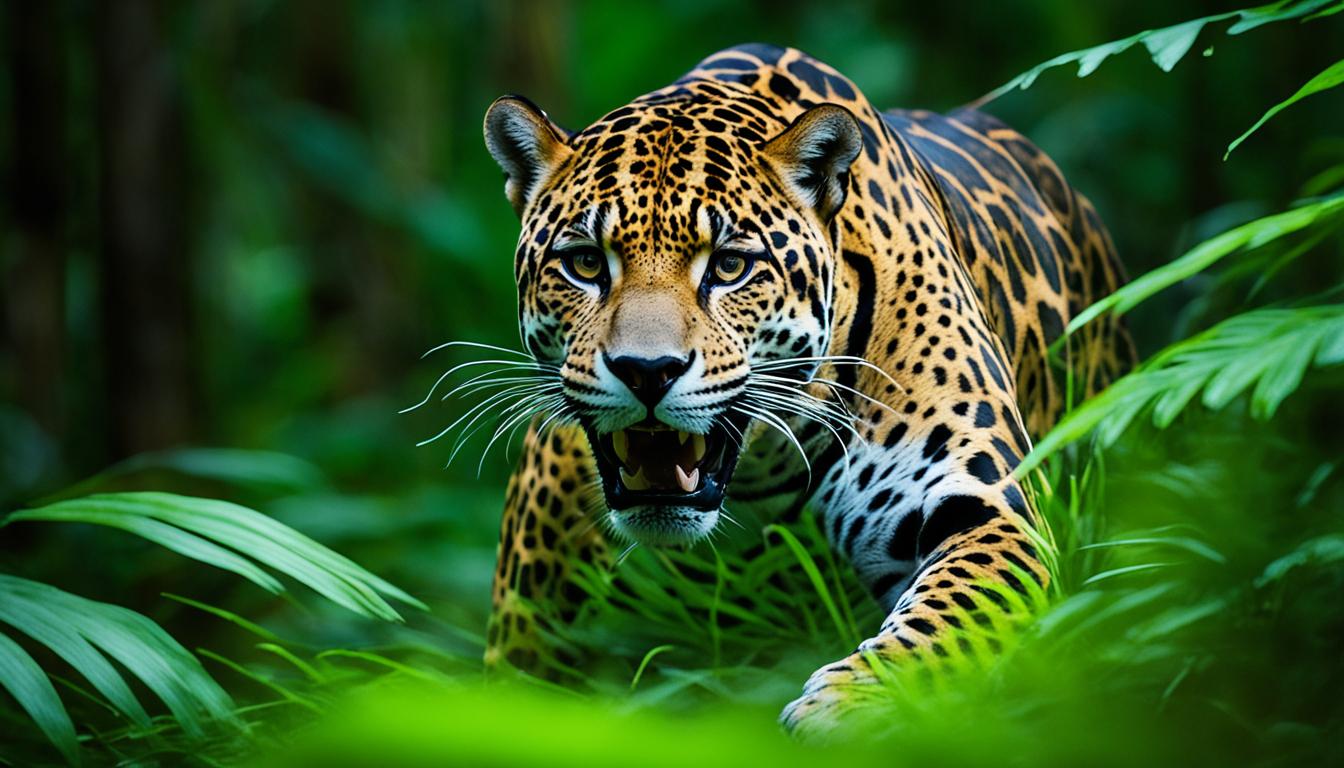
Jaguars are known to reach up to 50 miles per hour (80 kilometers per hour). This makes them the largest and one of the fastest cats in the Americas. Their speed and agility are perfect for hunting, making them top predators.
Jaguars display a mix of power and grace in their habitat. Their speed helps them in hunting, setting them among the fastest cats. Every bit of speed gives them an edge in the wild.

People often wonder about the amazing abilities of jaguars. They want to know how these animals can move so fast and what it means for nature. Learning about their speed helps us understand their importance in the ecosystem. We get to see why the jaguar is among the most remarkable animals on Earth.
The Astonishing Speed of Jaguars
Jaguars are top predators, known for their incredible speed. They can run up to 50 miles per hour. This makes them skilled hunters. Compared to other big cats, this speed is vital for survival in their environment.
Jaguar's Top Speed in Context: Compared to Other Big Cats
Jaguars stand out in the animal kingdom with their speed. While not the fastest, their speed is remarkable. Cheetahs may be quicker, but jaguars excel in sudden sprints. Tigers and Leopards are slower but have others assets !
If you wish to know more how fast can a tiger run, please check our full article about this topic!
In an other hand, you can also check about the leopard top speed, you might be surprised!
The Role of Speed in Jaguar's Hunting Techniques
For jaguars, speed is about more than chasing. It's a mix of power and smart hunting. They hunt in dense places, using surprise. This way, they quickly catch their prey, showing how good they are at hunting.
Understanding Jaguar's Peak Performance in Short Bursts
Jaguars show their best speed when hunting. They quickly speed up to catch fast prey. This shows they are among the top predators. Their speed is a key part of their survival.
The Anatomy of Speed: Physical Adaptations for Jaguar’s Quickness
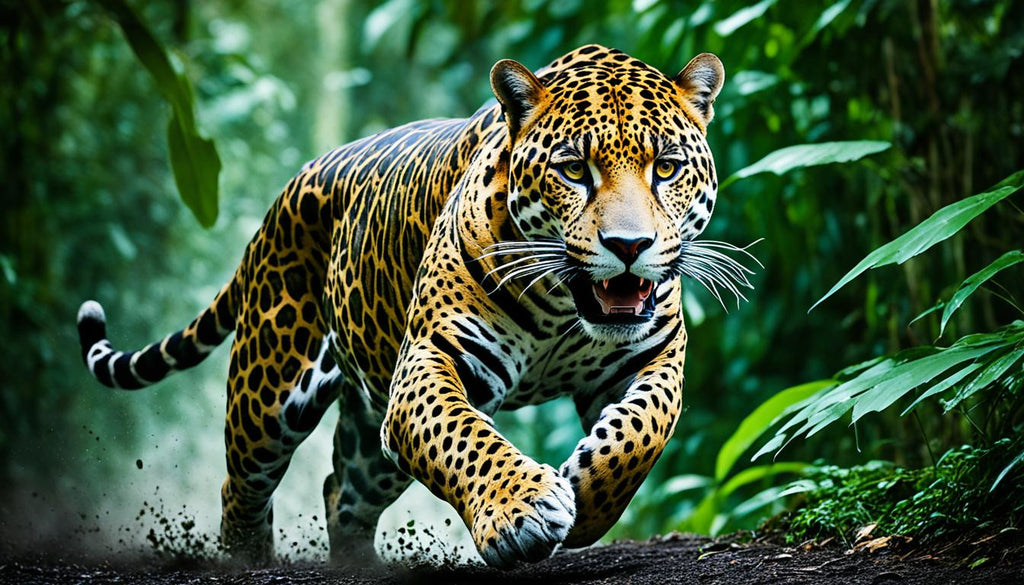
Jaguars are known for their impressive agility and capability for fast burst speeds. This is thanks to their unique body design. These incredible animals have developed muscular and skeletal systems that are perfect for speed. It's what they need to survive in the wild.
Muscle Structure and Its Impact on Jaguar's Swiftness
The anatomy of a jaguar shows nature's ultimate engineering work. At the heart of their explosive speed are compact, powerful muscles. These muscle fibers work like springs, ready to release energy at any moment. This not only helps jaguars sprint suddenly but also lets them change direction quickly. This agility is vital for chasing prey or moving through the forest.
Skeletal Adaptations Conducive to High-Speed Pursuits
The jaguar's bones are just as important as its muscles for its speed. Their spine stretches and compresses, which helps with their fast movements. This flexible backbone is amazing. It lets them leap over obstacles with ease. Their strong leg bones endure the force of running fast, which is key when they hunt.
Their shoulders move freely since they don't have collarbones. This movement is crucial for their hunting strategy. It shows how their body's design works perfectly for catching prey.
Tracking the Jaguar: Habitat and Geographic Range
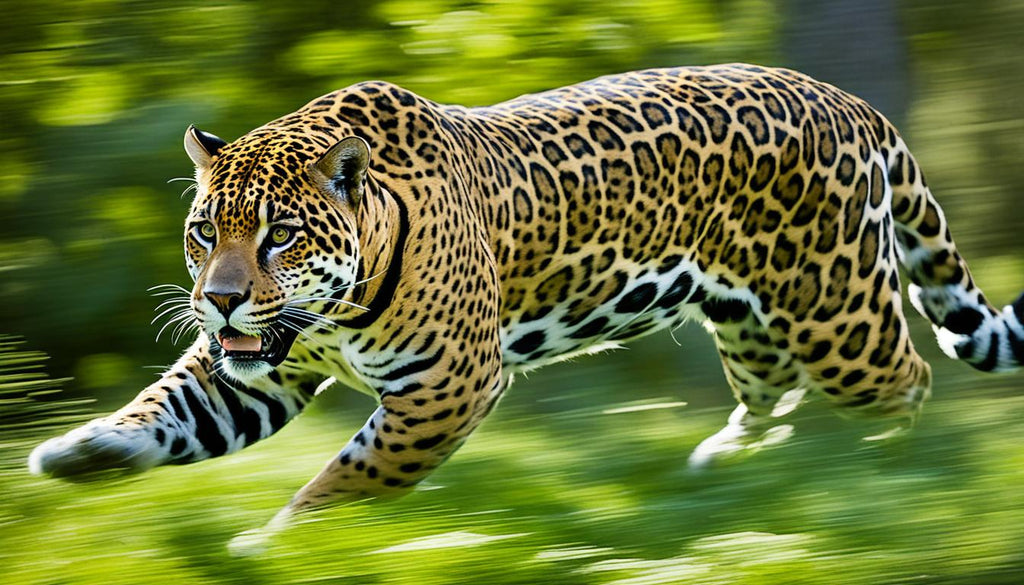
The jaguar, with its incredible speed, has always been fascinating. It lives in many habitats across the Americas. Being the world's third-largest big cat, its home ranges from rainforests to wetlands.
Preferred Habitats for Optimal Speed and Hunting
Jaguars love certain habitats. These offer the right mix of hiding spots and open spaces. They need these for survival and to be successful hunters.
The dense rainforests and complex wetlands are perfect for them. Here, they can hunt quickly and quietly. They use everything in their habitat to stay top predators.
Navigating the Diverse Terrains of Jaguar’s Habitats
Jaguars roam across the Americas, showing how well they adapt. They live in the Amazon rainforest and the Pantanal wetlands, to name a few places. Each area comes with its own challenges but also chances for the jaguar to shine.
They have great hunting skills and speed. Their ability to adapt is why we must protect their homes. This way, jaguars will continue to rule over their vast and changing worlds.
How Fast Can a Jaguar Run in Miles and Kilometers?

People often wonder: how fast can a jaguar run? Jaguars' speed shows their amazing hunting abilities. They can go up to 50 miles per hour, making them some of the fastest big cats.
Measured in kilometers per hour, they can hit approximately 80 kilometers per hour. This speed points to their adaptability and hunting skills. It gives us a glimpse into their world and evolutionary progress.
Few creatures can compete with the sheer burst of acceleration that a jaguar can produce in the pursuit of its prey.- Jaguars' acceleration allows them to exploit the element of surprise, contributing greatly to their hunting strategy.
- The speed of a jaguar is most efficiently used in short, powerful bursts during such predatory rushes.
- This breathtaking top speed maintains the jaguar's status as one of the foremost apex predators in its range.
Watching these animals run, you're struck by their power and elegance. It's like seeing natural athleticism in action.
The Jaguar's Predatory Edge: Speed and Stealth
The jaguar is an amazing hunter because of its predatory edge. This includes its speed and stealth. Over time, it has become great at surprising its prey. This skill is why it catches food so well.
Jaguar's Ambush Strategy and the Element of Surprise
Jaguars are made for sneaky attacks. Their fur helps them hide, blending in perfectly. They move without making a sound. This lets them surprise their prey.
When the time is just right, they use their fast speed. This lets them catch even the most careful animals.
How Speed Enhances Jaguar's Hunting Success
When a jaguar attacks, its speed is key. This quick burst turns their sneaky approach into a catch. Their speed gives them an advantage over other animals.
This means they are really good at hunting. It keeps them at the top of the food chain.
Lifespan and Health: How Long Do Jaguars Maintain Their Speed?
The majestic jaguar, known for its strong health and hunting skills, moves through the wild with great agility and speed. Its survival partly relies on keeping its speed as it ages. This reveals much about how jaguars live and what we must do to protect them.
Age-Related Changes in Speed and Agility
Jaguars show incredible resilience throughout their life, staying top predators despite aging. Their speed may decrease over time, but they adapt. With age, they become wiser, which helps them remain effective hunters.
Health Factors Affecting Jaguars' Running Capacity
A jaguar's health greatly affects its hunting success. Its ability to run fast is crucial for survival. Today's threats harm not just single animals but the whole species. Protecting their ability to stay strong and quick is a responsibility we all share.
| Age Range | Typical Health Status | Estimated Speed and Agility |
|---|---|---|
| 0-3 years | Prime Juvenile Condition | Peak Potential |
| 4-8 years | Optimal Adult Form | Highly Proficient |
| 9-12+ years | Varies with Individual Health | Moderate to Declining |
Threats to Jaguar's Speed: Impact of Human Activities
The jaguar is an icon of speed and strength. Yet, it faces challenges from human actions that threaten its survival. Deforestation in Central and South America is destroying their homes. This leads to smaller areas for jaguars to live and hunt, breaking up their living spaces.
Farming also pushes these majestic animals out of their natural settings. As we turn forests into farms, jaguars lose their homes. This habitat loss hurts their hunting, living, and the balance of nature.
Conflicts with humans add to the jaguars' troubles. They're often killed for threatening livestock. When their prey is scarce, they might come near our homes, raising the chance for conflicts.
Poaching is a serious risk too. The high value of jaguar fur and parts tempts poachers, threatening their survival. This makes living even harder for them.
| Threat | Impact on Jaguars |
|---|---|
| Deforestation | Loss of natural habitat, reduced hunting grounds, fragmentation of territory |
| Agricultural Expansion | Displacement, increased human-jaguar encounters, ecosystem imbalance |
| Human Conflict | Mortality from protective killings, disruption of natural behavior, stress-induced health issues |
| Poaching | Decrease in population, disruption of social structures, long-term species endangerment |
We must realize how our actions affect jaguars. They need large areas to roam and hunt freely. If we don't change, we risk losing the unique essence of jaguars.
Conclusion
In our journey to understand the jaguar's speed, we've learned how amazing these animals are. They are one of the fastest big cats, thanks to their powerful muscles and quick reflexes. Their top speeds show just how well-adapted they are, making them stand out in the animal kingdom.
Jaguars are not just fast; they are also smart hunters. Their hunting agility and speed are the result of years of evolution. This mix of abilities shows how magnificent they truly are, earning our admiration and awe. Jaguars are masters of their domain, hunting with incredible grace and skill.
But jaguars face real threats from humans, such as losing their homes and illegal hunting. These dangers threaten their very survival. We must act together to protect these incredible animals. By doing so, we ensure they keep running through their homes, impressing all who see them. Our actions are crucial for keeping jaguars safe in their natural habitats.
FAQ
Q: What is the top speed of a jaguar in miles per hour?
A: Jaguars can reach speeds up to 50 miles per hour in short bursts.
Q: How does a jaguar’s speed compare to that of other big cats?
A: Jaguars are fast but not the fastest. They run slower than cheetahs. Leopards hit 50 miles per hour, and tigers 40. But cheetahs are the speed kings at 70 miles per hour.
Q: What role does speed play in a jaguar's hunting techniques?
A: Speed lets a jaguar ambush prey quickly. They use surprise and short, fast charges to catch their prey.
Q: How are jaguars physically adapted for high-speed pursuits?
A: Jaguars have strong legs and bendy spines. This lets them speed up fast and make tight turns and big jumps. It helps them chase and grab prey quickly.
Q: What habitats do jaguars prefer for optimal hunting and speed?
A: Jaguars love dense rainforests and wetlands. These places offer good hiding spots for ambushes and room for quick, sneaky moves.
Q: Can you provide the top speed of a jaguar in kilometers per hour?
A: Sure, a jaguar's top speed is about 80 km/h during quick sprints.
Q: How does the jaguar's speed contribute to its hunting success?
A: The jaguar's speed helps it sneak up and then suddenly jump on its prey. This trick works well in the thick places they live.
Q: How long do jaguars maintain their top speed as they age?
A: Jaguars stay fast and agile as grown-ups. But getting older might slow them down a bit. This could make hunting harder.
Q: What human activities threaten the jaguar's ability to utilize its speed?
A: Things like cutting down forests, expanding farms, ruining habitats, and fights with humans hurt the jaguar's home. This makes it tough for them to use their speed to hunt and stay alive.
Check out our article about: Is a Panther a Jaguar?
Also in Tiger Blog
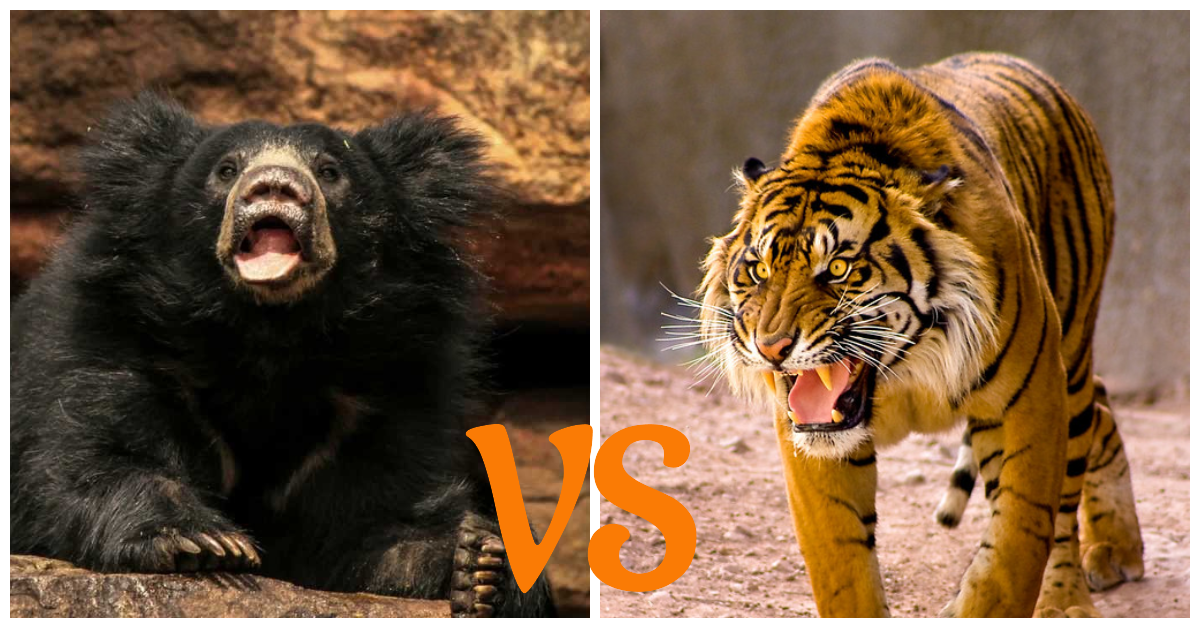
Sloth Bear vs Tiger: Who Would Win?
July 13, 2024 7 min read
Explore the thrilling showdown between a sloth bear and a tiger, analyzing their strengths, behaviors, and survival tactics.
Read More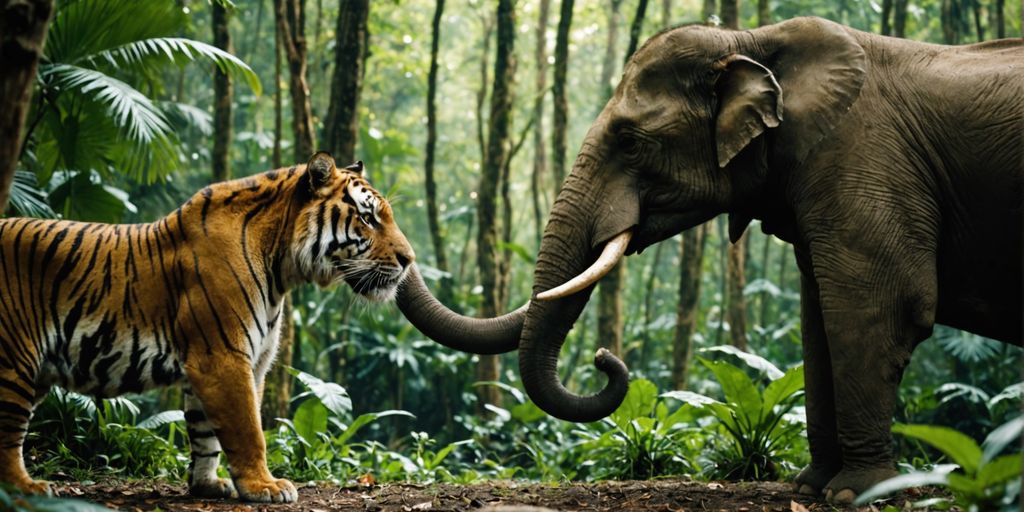
Tiger vs Elephant: Who Reigns Supreme in the Animal Kingdom?
July 13, 2024 7 min read
Explore why elephants usually triumph over tigers in the wild, highlighting their size, strength, and defensive prowess.
Read More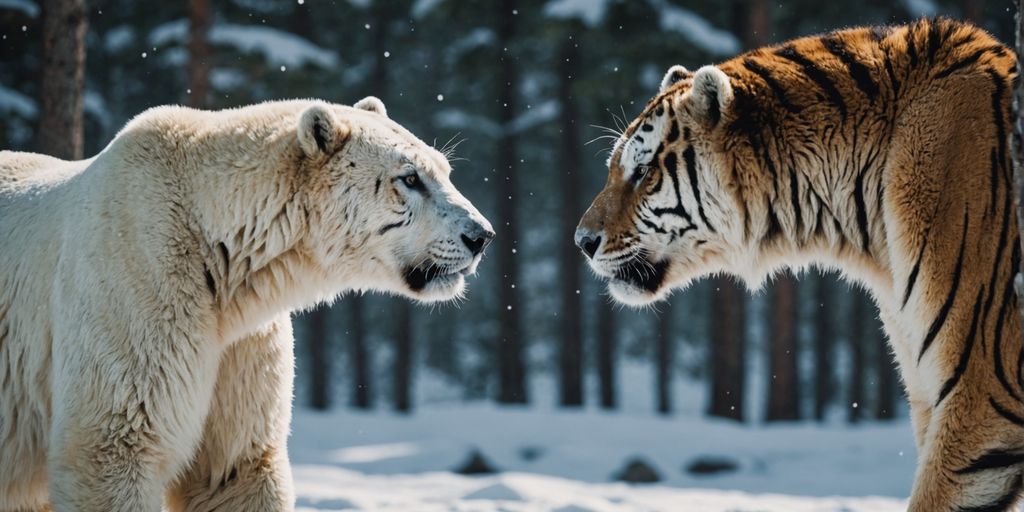
Epic Battle: Polar Bear vs Tiger, who win?
July 11, 2024 8 min read
Epic showdown: Polar Bear vs Tiger. Discover who would win in this thrilling battle of nature's fiercest predators.
Read More